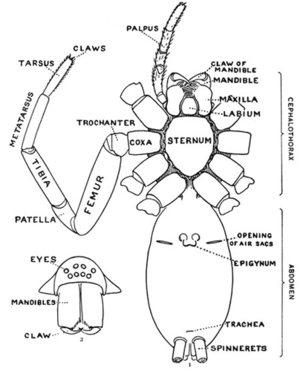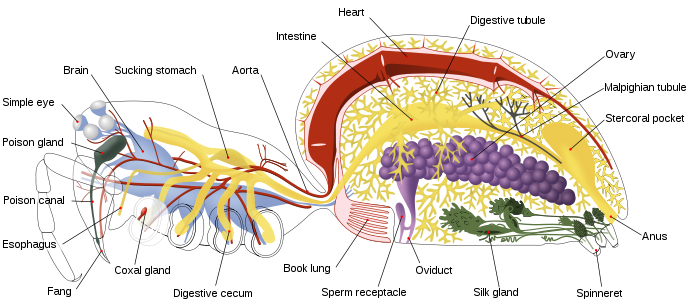
Epigyne
Encyclopedia


Spider
Spiders are air-breathing arthropods that have eight legs, and chelicerae with fangs that inject venom. They are the largest order of arachnids and rank seventh in total species diversity among all other groups of organisms...
s. As the epigyne varies greatly in form in different species, even in closely related ones, it often provides the most distinctive characteristic for recognizing species. It consists of a small, hardened portion of the exoskeleton
Arthropod exoskeleton
Arthropods are covered with a tough or resistant exoskeleton, which may be mineralised or constructed of a tough polymer such as chitin. This external skeleton is moulted as the organism grows.- Microscopic structure :...
located on the underside of the abdomen, in front of the epigastric furrow and between the epigastric plates.
Functions
The primary function of the epigyne is to receive and direct the palpal organPedipalp
Pedipalps , are the second pair of appendages of the prosoma in the subphylum Chelicerata. They are traditionally thought to be homologous with mandibles in Crustacea and insects, although more recent studies Pedipalps (commonly shortened to palps or palpi), are the second pair of appendages of the...
of the male during copulation. The various specific forms of epigynes are correlated, in each case, with corresponding specific differences in the palpus of the male. This specialization prevents individuals of different species from mating. The epigyne covers or accompanies the openings of the spermatheca
Spermatheca
The spermatheca , also called receptaculum seminis , is an organ of the female reproductive tract in insects, some molluscs, oligochaeta worms and certain other invertebrates and vertebrates...
e, which are pouches for receiving and retaining sperm. Frequently, the openings of the spermathecae are on the outer face of the epigyne and can be easily seen.
A secondary function of the epigyne is as an ovipositor
Ovipositor
The ovipositor is an organ used by some animals for oviposition, i.e., the laying of eggs. It consists of a maximum of three pairs of appendages formed to transmit the egg, to prepare a place for it, and to place it properly...
.
Differences in form
An example of a comparatively simple epigyne is that of Pirata montanus. It consists of a nearly plain plate, with the openings of the spermathacae near the posterior lateral corners. A somewhat more complicated form is illustrated by the epigyne of Trabeops aurantiacus. In this species, the plate is depressed or furrowed longitudinally, and the depressed area is divided by a ridge-like elevation, which divides the depression into two furrows or channels, each of which leads to the opening of the spermatheca of the corresponding side. This ridge-like elevation is called the guide, as its function "seems clearly to be that of a guide to the male embolus, controlling the course of the latter and facilitating its entrance to the spermatheca." In many cases the guide extends laterally on each side at its posterior end. This is true to a slight extent in the epigyne of Trabeops, but more markedly so in that of many species of Geolycosa, where the lateral expansions often conceal the openings of the spermathecae, as in the epigyne of Geolycosa pikei.A more complicated form of epigyne is found in spiders of the genus Araneus
Araneus
Araneus is a genus of common orb-weaving spiders. It includes about 650 species, among which are the European garden spider and the barn spider.-Description:...
, where there is developed an appendage which is usually soft and flexible, and which is termed the scape or ovipositor. When there is a well-developed scape, the tip of it is usually more or less spoon-shaped. This part of the scape is termed the cochlear. The basal plate of the epigyne which bears the scape, and which forms a porch or hood that covers the opening of the oviduct is called the atriolum.
A still more complicated form of epigyne is found in some of the sheet weavers (Linyphiidae
Linyphiidae
Linyphiidae is a family of spiders, including more than 4,300 described species in 578 genera worldwide. This makes Linyphiidae the second largest family of spiders after the Salticidae. New species are still being discovered throughout the world, and the family is poorly known...
) and orb weavers (Araneidae), where the ovipositor consists of two finger-like projections: first, the more common one, the scape, which arises from the atriolum, and consequently in front of the opening of the oviduct; and second, one which arises behind the opening of the oviduct; this is termed the parmula. Each of these projections may be grooved on the side facing the oviduct, forming a tube.

